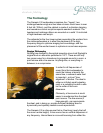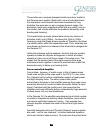
24
2424
24
absolute fidelity
The woofers are a uniquely designed metal cone driver made for
the Genesis servo system. Made with a cone of solid aluminium,
the suspension and voicecoil have been maximized for long
distortion-free excursion so as to increase dynamic range. Our
aluminium cones are a magnitude stiffer than any plastic cone on
the market, and virtually eliminate the problems caused by cone
bending and break-up.
The lowest break-up mode (where there can be any chance of
distortion at all) is at 6,000Hz – far above the 16Hz to 120Hz
frequency range that these drivers operate at. Therefore, the driver
is a perfect piston within the frequencies used. Thus, extremely low
cone break-up distortion is inherent in the driver that is designed for
the Genesis 2.2.
Unlike the midrange and the tweeters, the front and rear woofers
operate in phase as a bipolar arrangement in which all sixteen
operate in unison to control the air mass of the entire room. This
means that the surface area of the eight cones and the large
enclosure all work together in unison to produce bass output that
descends evenly to below your hearing limits.
Servo-controlled Amplifier
One problem, however, of metal cones, is that of greater mass
(even ones as light as the ones used in the G2.2). To over come
this, Genesis had to build an amplification system of great power,
and high damping factor. The servo system also places
extraordinary demands on the amplifier because the system uses
enormous amounts of current to make the woofer follow the input
signal. Combined with the metal cones, this means that the
amplifier used must efficiently deliver extraordinarily large amounts
of clean power into very low impedances.
In the Genesis 2.2, the amplifier was designed as a holistic system
of woofers, integrated connecting cables, amplifiers, servo-control
and remote controlled crossover circuitry. Two separate two-
channel amplifier modules are used for the left and right woofer
towers.
Specially designed and tuned “Dynamic Reserve” power supplies
are used – one for two channels – to deliver balanced dynamics
which are critical to bass accuracy. This improves the power factor


















